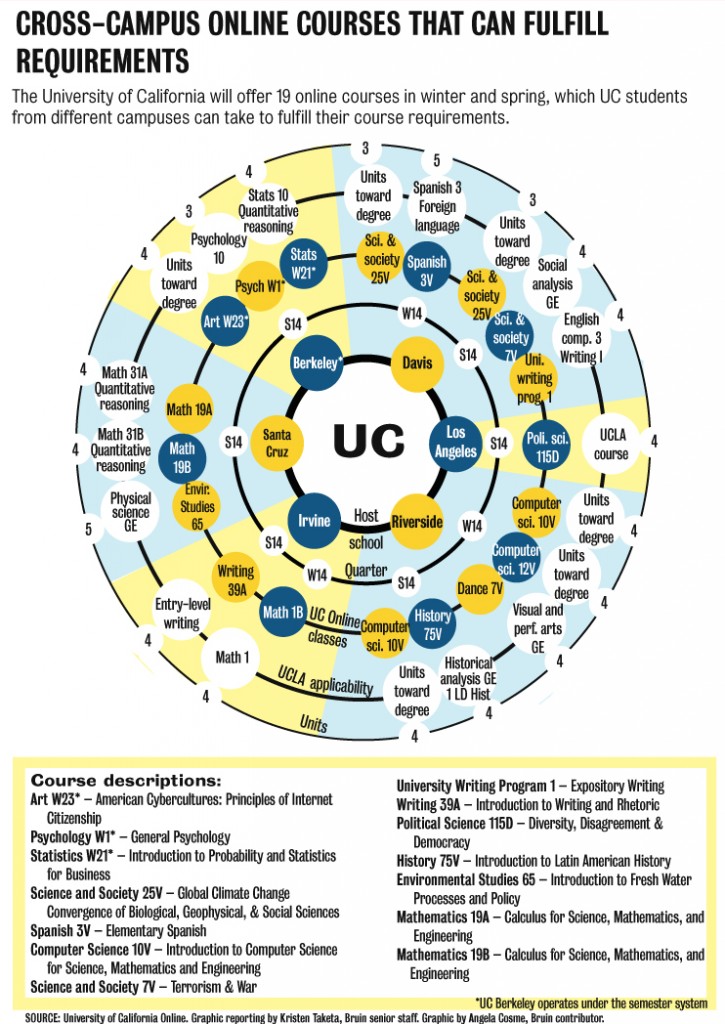The University of California recently unveiled a new list of online courses, including one from UCLA, that will be available starting this winter and satisfy graduation requirements at multiple campuses.
Twenty two courses, mostly high-demand introductory classes, will be offered throughout this academic year, according to Ellen Osmundson, the project coordinator of the Innovative Learning Technology Initiative program. The courses will include subjects such as calculus, English composition, computer science, and dance history, among others. UCLA will host one of the online courses spring quarter, an upper division political science class about democracy and diversity.
The UC is using $10 million from the state budget to fund the new online initiative. Part of the funding will be used to hire teaching assistants at each campus to lead the discussion localized discussion sections, according to a UC proposal.
The proposal said officials expect the state funding to continue for three years before the program is re-evaluated.
Students cannot enroll in the online courses yet, said Frank Bäuerle, a continuing lecturer of mathematics at UC Santa Cruz who teaches an online class. However, right now the webpage for UC Online points out that students can request more information about the classes.
All of the courses offered through the program this year will qualify for units and college requirements at UCLA, according to the UCLA Registrar’s website.
Although the individual courses will have a professor giving a lecture from the home campus, Bäuerle said the support from teaching assistants at each campus is important.
Of the $10 million earmarked, $2 million will be used to fund teaching assistants. An additional $5 million will be used to design and create courses throughout the University and $3 million will be used to build a “hub” for cross-campus communication on student enrollments and grades, according to the proposal.
This initiative expands on the UC Online program, which launched in 2012. The new initiative aims to offer more lower division courses, instead of the upper division courses the UC Online program currently focuses on.
Similiar to UC Online, courses will be available at no extra cost to current UC students. Non-UC students may take an unlimited number of online courses for $350 per unit for a class on the quarter system.
The program is meant to use technology to expand access to high-demand introductory courses, said Jim Williamson, UCLA’s director of educational technology services and administration.
The UC is currently facing a spike in the number of undergraduate applicants, and in response, must increase the availability of some courses, Williamson said.
Austin Kassels, a first-year physiological science student, said he would consider an online class if he couldn’t fit a traditional class into his schedule.
The UC has grappled with an increase in enrollment in the past, Williamson said. The University tried to solve the problem in other ways, including constructing a new campus, UC Merced, in 2005.
But building new campuses is an unsustainable solution, he said. The recent increases in high school graduates and community college transfer students have led the University to seek new ways to solve its capacity problem.
Williamson also said simultaneous enrollment, which allows students to take classes at other UC campuses, already exists. However, it requires the student to physically attend classes at the campus where the course is offered and fill out a lot of paperwork.
Susanne Lohmann, a political science professor at UCLA who is teaching a course for the program this spring quarter, said paying for teaching assistant’s for each campus may be a challenge. If not enough students sign up for an online class, it would not be worth it to pay for a teaching assistant, she said.
Emily Kyle, a second-year English and psychology student, said in her experience with online education she has found that the format is not ideal because she is primarily an auditory learner. She added that she found online courses to be impersonal.
“For us, being used to being present (in the classroom), it might be kind of a hard translation,” Kyle said.
Williamson said the UC will treat online courses with the same scrutiny that on-campus courses receive, and the courses will be reviewed by faculty and the academic senate as regular classes are.
Bäuerle said he thinks the initiative is a good way to partially relieve the capacity issues some introductory classes, like the introductory calculus lecture he will teach, are subject to.
Despite concerns about the program, Bäuerle said he thinks many students will do well in online classes because of his past experience teaching them.
“It’s really cool that we have the opportunity to connect people that cannot be physically in the same place. … As far as I can tell it’s working,” he said.
